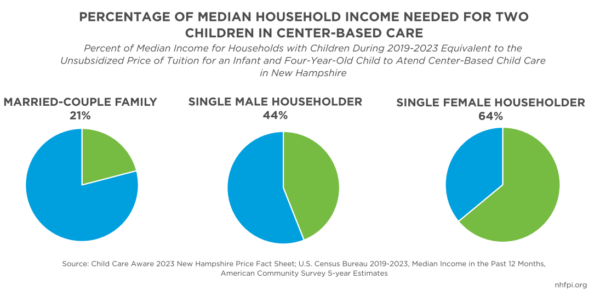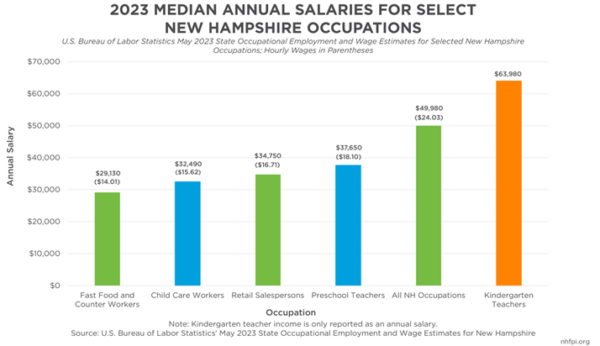This fact sheet provides a snapshot of key facts about early care and education in New Hampshire.
Child Care is Unaffordable for Most Granite State Families
- In 2023, the average annual price for an infant in center-based child care in New Hampshire was $17,250, and $11,402 annually for family child care. The average annual price for both an infant and a four-year old in center-based care was $31,868.[1]
- The federal government set an affordability benchmark of seven percent of household income for child care.[2] For the 2019-2023 period, median-income single male householders would have needed to spend 44 percent of their household incomes for an infant and four-year-old child in center-based care, while median-income single female householders would have needed to spend 64 percent.[3]

Demand for Child Care Exceeds Available Spots
- On average between 2019 and 2023, an estimated 53,752 New Hampshire children under 6 years old (73 percent) lived in families that may have required child care, as both parents or the sole parent of the household were in the labor force.[4]
- During 2019-2023, there was an average of approximately 44,645 licensed child care slots, resulting in an average annual shortage of about 9,107 slots during these five years.[5]
- Fewer child care spots may have been available in practice during the 2019-2023 period. September 2024 data suggest that New Hampshire providers were operating at 86 percent of their licensed capacity. A 2023 State report estimated an early childhood educator vacancy rate of 26 percent. Some providers may also suppress child-teacher classroom ratios to better meet the needs of children and teachers in the facilities.[6]

Workforce, Economic, and Societal Impacts
- LOW WAGES: The median hourly wage for a New Hampshire child care worker in 2023 was $15.62 while the median wage of retail salesperson was $16.71. The median wage for all New Hampshire occupations was $24.03.[7] Child care workers earned just over half of the median salary of New Hampshire’s kindergarten teachers.
- HIGH TURNOVER: Turnover for child care workers is projected to be 17 percent annually from the second quarters of 2023 and 2025 compared to a projected 11 percent turnover for all occupations.[8]
- WORKFORCE IMPACT: In 2024, an average of nearly 17,300 Granite Staters each month were not working because they were caring for children who were not in school or daycare.[9]
- RETURN ON INVESTMENT: Key research suggests a return of $4.20 for every $1 invested in high-quality state and district pre-Kindergarten programs for families with low incomes. Children who participate in these programs are more likely to finish high school, as well as have higher wages and lower health care costs later in life. These children are also less likely to need public assistance or engage in criminal activity in their lifetimes.[10]
[1] See Child Care Aware’s 2023 New Hampshire Fact Sheet for information about the price of child care in New Hampshire.
[2] See p. 3 of September 30, 2016 U.S. Department of Health and Human Services Administration for Children and Families Office of Child Care Final Rule in Rules and Regulations.
[3] Estimates were generated using Child Care Aware’s 2023 New Hampshire Fact Sheet and the U.S. Census Bureau’s 2019-2023 American Community Survey five-year estimates, Table S1903 Median Income in the Past 12 Months (in 2023 Inflation-Adjusted Dollars) for New Hampshire.
[4] Estimates calculated using U.S. Census Bureau’s American Community Survey 2019-2023 five-year estimates, Table B23008 Age of Own Children Under 18 Years in Families and Subfamilies by Living Arrangements By Employment Status of Parents.
[5] See 6-13-2024 data provided by NH Child Care Licensing Unit to the NH Child Care Advisory Council. Note: The number of children with two parents, or their sole parent, in the workforce may be an overestimate, as not all families may want to use child care despite their employment status.
[6] See the March 29, 2023 Fiscal Item FIS 23-124 from the New Hampshire Department of Health and Human Services; New Hampshire Department of Health and Human Services, Bureau of Child Development and Head Start Collaboration, September 2024 New Hampshire Child Care Profile.
[7] See U.S Bureau of Labor Statistics’ May 2023 State Occupational Employment and Wage Estimates for New Hampshire.
[8] Note: Turnover was calculated by combining exits from the workforce with transfers to other occupations. See New Hampshire Employment Security’s Short-term Employment Projections, 2023 Q2 to 2025 Q2.
[9] See the U.S. Census Bureau’s Household Pulse Survey data collections from Phase 4.0 Cycle 01 to Phase 4.2 Cycle 09.
[10] See the Urban Institute’s September 14, 2023 report, The Return on Investing in Children: Helping Children Thrive, page 15.
